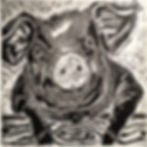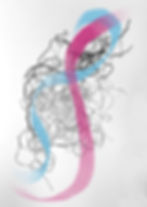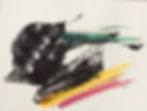Katherine Watts
Printmaking
Woodcut






You Pig 24" x 24" woodcut
Intaglio (with aquatint)


.jpg)







Screenprint




Monotype
To create these, I found during many explorations, a tow boat mooring line entangled within riverbank tree branches. After retrieving this line, weighing upwards of thirty pounds, it was placed in the sun to dry for several weeks. It was then carefully brushed, to remove large leaves, mud, and sand debris. After small pieces of the rope were selected and removed, they were inked, arranged on a press bed, and printed as a collagraph/relief print. In this method of monotype printing each print is unique; there is never, truly, any control of the outcome. The prints are treated as sequential, individual studies. This allows each rope piece to tell a different story, without the artist's interference with its message. Then, the story can continue, in the viewer's response to and interpretation of the print. Some prints also include foraged/found plastic.








Drawing
Digital and Traditional

Photography

Mycology
Mycology and mycoremediation are recurring influences of many different research endeavors that regularly appear throughout my work. For example, an immersive micro-landscape or research-based spore print stemmed from the observation of a diverse habitat of numerous mushrooms during foraging.
Some mushrooms have the ability to filter out toxic waste from the environment. One of these mushrooms is the Pestalotiopsis microspora, which consumes polyurethane and converts it into organic matter; another is the Aspergillus tubingensis, which can break down the bonds between plastic molecules in a matter of weeks. Fungi can also feed on various other toxic substances, such as oil spills, radioactive waste, and certain types of nerve gases.
Such possibilities are as intriguing as are the seemingly desperate dynamics between humans, our own involvement and awareness levels, and our impact on the biosphere within which we live.
Fungi










Mother Nature









